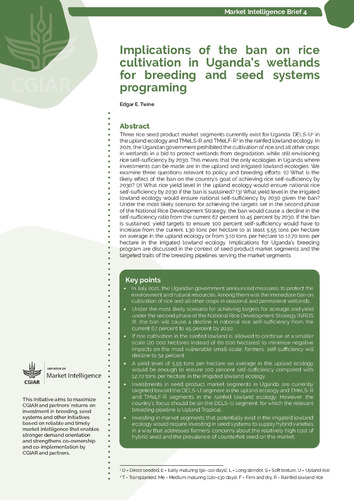Abstract/Description
Three rice seed product market segments currently exist for Uganda: DELS-U1 in the upland ecology and TMeLS-R and TMeLF-R2 in the rainfed lowland ecology. In 2021, the Ugandan government prohibited the cultivation of rice and all other crops in wetlands in a bid to protect wetlands from degradation, while still envisioning rice self-sufficiency by 2030. This means that the only ecologies in Uganda where investments can be made are in the upland and irrigated lowland ecologies. We examine three questions relevant to policy and breeding efforts: (1) What is the likely effect of the ban on the country’s goal of achieving rice self-sufficiency by 2030? (2) What rice yield level in the upland ecology would ensure national rice self-sufficiency by 2030 if the ban is sustained? (3) What yield level in the irrigated lowland ecology would ensure national self-sufficiency by 2030 given the ban? Under the most likely scenario for achieving the targets set in the second phase of the National Rice Development Strategy, the ban would cause a decline in the self-sufficiency ratio from the current 67 percent to 45 percent by 2030. If the ban is sustained, yield targets to ensure 100 percent self-sufficiency would have to increase from the current 1.30 tons per hectare to at least 5.55 tons per hectare on average in the upland ecology or from 3.10 tons per hectare to 12.70 tons per hectare in the irrigated lowland ecology. Implications for Uganda’s breeding program are discussed in the context of seed product market segments and the targeted traits of the breeding pipelines serving the market segments.

